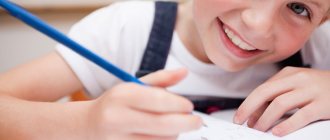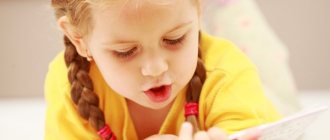Letters surround us everywhere. The child sees them in books and magazines, on food packages, and in store windows. He can't help but wonder what it is. Over time, he begins to understand that adults can read, begins to copy his parents, learning a poem or fairy tale by heart, and pretending that he is reading a book.
Experts recommend teaching a child to read shortly before school, since at an earlier age his brain is not yet ready to perceive such information. You can learn sounds with it, learn to distinguish them in spoken speech, and begin to master the alphabet. This preliterary period is very important, since thanks to it the child will be able to learn to read fluently and understand what he reads.
At what age do you start learning letters?
Many parents are sure that a child’s development should begin almost from the cradle. But neuropsychologists warn that it is harmful to learn letters and numbers before the age of 3. At this age, the emotional and sensory sphere should be formed. If we force a child to study, we violate the laws of brain development, which can have negative consequences.
No specialist will tell you that at 3 or 4 years old a child should know all the letters. Of course, if you wish, you can force him to learn the alphabet, but this will not bring any benefit, and, on the contrary, can do harm. The brain is ready for reading most often by 5-6 years, and only in 20% of children - by 4-5. Before this time, you should not study letters.
But this does not mean that you can forget about the development of the child. At 3-4 years old, you need to work on speech development, teach your child to ask and answer questions correctly, pronounce words, and study the world around him. We need to work on fine motor skills, teach him to dance, develop a sense of rhythm, and so on.
These are the recommendations. However, all children are different. If your child shows a sudden interest in letters, it means it’s time to start learning. And it doesn’t matter if it appeared late, for example, at 6 years old. The child must want to read, only after that you can study with him.
Psychologists note several signs that indicate a child’s readiness to learn:
- The child understands what he reads well and can tell what the book is about.
- He knows how to construct phrases and pronounce all sounds.
- Interested in what is written in a children's magazine, book or poster.
- Pretends to read, imitating adults.
If all these signs appear, you can begin classes. You can’t put pressure on a child, force him to study, bribe him (“if you learn the letters, I’ll give you a chocolate bar”) - you won’t achieve anything with this.
In cases where interest in letters appeared early, there is no need to give up classes. But do not overload your baby, work with him for no longer than 7 minutes, classes do not have to be done every day, you can take breaks of 2-3 days.
How to teach a 4 year old child the alphabet at home?
Many parents wonder how to learn the alphabet. There are many ways, but the most effective is learning through interesting games that you will want to return to.
Games for learning the alphabet and numbers
There are many games to help you learn letters and syllables.
Note! You shouldn’t get hung up on one method; the best option would be to combine several types of games so that the learning process remains fun even after several weeks of classes.
Learning by playing
The game form of presenting the material facilitates its easy assimilation. Children love to play, so if you present educational material through games, the child will learn with pleasure.
As a game you can offer your baby:
- modeling;
- coloring books;
- cutting letters from different materials;
- assembly of cut cards with the image of letters.
Let's make letters
Modeling is a very useful learning option. It uses several sensory organs at once and helps in the development of hand motor skills.
Letters can be assembled from different pieces prepared in advance, or they can be folded from long “worms” by assembling and twisting into letters.
Coloring the letters
Coloring can be an excellent teaching material. The alphabet can be presented in the form of pictures or pure images of letters.
Note! If a child has just begun to learn letters, images with letters and pictures will be more suitable for him, and the posted images will help him remember the letters through associations.
Tasks of sensory development of children of early and preschool age
Cut out letters from paper
This method will add variety and help develop fine motor skills. It is useful to cut out paper blanks (rectangles, squares and circles) and fold letters from the parts together with your child.
Edible letters
The child will be more interested in the process if learning is associated with positive emotions. Making letters edible is a great way to spice things up.
You can bake cookies together in the form of the alphabet, put together letters and syllables from chopped vegetables, and also draw letters with jam on the surface of pancakes and porridge.
Modeling letters
Where to start learning the alphabet?
The child began to show interest in letters. There is no need to immediately load him with knowledge, cram the alphabet. Move little by little. The easiest way for children to remember is the first letter of their name. Explain to him what this letter is and what it is called. You can ask him to find this letter in the text. Gradually he will learn to highlight it and will pay attention to it. The first step has been taken.
Parents now trust various children's tablets, phones and other similar toys to educate their children. Remember that they are learning to pronounce letters, not sounds. Kids need to be taught sounds, so it will be easier for them to master reading.
A letter is a graphic representation of a sound, each has its own name. But learning to read knowing only the names of letters is very difficult. Imagine that a child will need to read the word “ball”. How will he do this? The way he was taught: “baael.” And all because he pronounces letters, not sounds.
It is better to start learning with sounds, pronouncing them with your child. Parents themselves should not confuse sounds and letters. Sound is what we hear. A bumblebee buzzes is a sound, a hammer knocks is also a sound. But we cannot get words from all sounds. If we clap our hands, the sound will appear, but the word will not.
You can create a word from special sounds called speech sounds. Make sure that the child does not confuse the letter and sound. Explain to him that a letter is an icon that can be seen in a book or drawn on paper. Letters can be seen with our eyes, and sounds we can hear.
Reading syllables of varying complexity
When moving from learning letters to reading sentences, correctly pronouncing syllables is an important developmental milestone. At the same time, it is important to show the child how words are formed from the sounds of letters.
Set of letters to study
Important! When learning syllables, it is important to accurately pronounce them out loud, reinforcing pronunciation. Subsequently, based on what you have learned, you can move on to reading words and sentences. Educational cartoons can help in mastering the pronunciation of syllables, for example, “The ABC with Cars.”
General recommendations for teaching a child
If you decide to study with a child, remember the basic rule - he should be interested. You can't force him. At this age, the easiest and most accessible way to learn is through play.
It is difficult for kids to concentrate and sit in one place for a long time, so classes should be short, 5-10 minutes. As soon as you notice that he is getting bored, move on to something else. If he forgot everything you went through, don’t get annoyed, repeat it again until he remembers. If you overload your child with information, he will develop an aversion to learning.
At an early age, a child develops visual-figurative thinking, and only then - abstract-logical thinking. This means that it is useless to draw letters on paper or a board. You won't be able to learn them that way. For him it will be just a set of dashes.
The child needs visual association. For example, if you are learning the sound "a" you can show him a picture of a watermelon or any other object that starts with that letter. Stock up on soft cubes with letters, bright cards, coloring books, and beautiful colored primers in advance.
You should not learn letters in alphabetical order. It is better to start learning with vowel sounds. The letters that are most often found in speech are studied first, then you can move on to rarer ones.
How to learn vowels?
First, explain to your child that all words are made of sounds, just like houses are built of bricks. The more sounds a word has, the longer it is. After this, you can move on to studying sounds.
Start with "a" . You can show your child pictures that depict objects whose names begin with this letter. Draw together the mouth that makes this sound, note how we open it wide. Let him try to name words that begin with this letter. Do not overload your child: 1 lesson - 1 letter.
Try to consolidate the acquired knowledge. Here you are going to kindergarten, you saw a pharmacy, let the kid try to find the letter that you studied. We bought a children's magazine, see if there is a letter “a” . You can mold a letter from plasticine or dough, or cut it out of paper. You can lay it out of sticks or sand.
It will be much easier for you to captivate your baby if you always have cubes with letters, bright books, and cards at hand. You can sing a song about a letter or listen to a funny poem.
So, learn all the vowel sounds one by one. Finally, you can explain that the sounds you have already learned are called vowels. These are sounds that can be sung. Try singing “a-a-a” or “oo-oo-oo” .
Remember that we have 6 vowel sounds ( a , o , u , e , s , and ) and 10 vowel letters. The letters i , e , ё , yu consist of 2 sounds. It is better to postpone the study of the latter until later, because there is no sound “I” , I is a letter consisting of 2 sounds. Do not confuse the child, so that later educators and teachers do not have to retrain him.
Rules for conducting classes
- Don't overload. 10-15 minutes will be enough. Regularity in this case will bring much more results than duration.
- Play . With preschool children, play is the only method of learning. It is at the moment of emotional uplift and psychological comfort that the child will be able to remember the information and apply it in the future. During a lesson that is structured taking into account interests, he will enjoy the process and develop a positive reaction to learning.
- Choose the right time and environment . A rested, well-fed baby in a good mood will happily get down to business. The room should be fresh, bright and, if possible, free from various distractions.
- Use visual images . At age 3, children may have difficulty understanding what an adult is saying. And if you give examples using toys, it will be much easier to understand the material.
How to learn consonants?
Once you have learned the basic vowels ( a , u , and , o ) you can move on to consonants. You need to start with the simplest consonants ( b , p , m , n , t , g ). And here again we remember that we teach the child sounds, not letters. We know that we need to say “ um ”, “ en ”, “ be ”, but children don’t need to know this yet. The child must learn that this is the sound “ mm ” or the sound “ nn ”. After the baby has mastered simple consonants, you can move on to studying sibilants.
Just like with vowels, knowledge needs to be consolidated. Children may confuse letters. To prevent this from happening, play association games. You can ask the children to think of what the letter looks like. Look for objects on the street that resemble this letter. For example, you walked past a horizontal bar, it is shaped like the letter “ p ”, or look at the doorway, it is also shaped like a “ p ”. Make it out of pencils, look for it in store signs.
Methods for learning the alphabet
There are several popular methods for teaching children to read and memorize the letters of the alphabet. You can use them, especially since experts worked on them. But, no matter what method you work with, it is important to remember that your classes should not resemble lessons at school.
Children at this age need to play and get the information they need through games. Therefore, after a short educational part, immediately move on to an interesting, gaming part. Creative activities are also very useful, with the help of which you not only learn letters, but also develop the child’s fine motor skills, improve his drawing and coloring skills, and strengthen the ability to use scissors.
Games and play exercises
There are a huge number of game exercises that will help you consolidate your knowledge. We will give a few as examples.
1. Find words with the right sound . You need to prepare cards that show different objects. The child must choose among them those that contain the sound being studied. First, you can simplify the task: ask him to find words starting with this letter.
2. Catch the sound . To warm up a little, mother and child walk around the room. Mom says different words. As soon as the child hears a word with the desired sound, he stops and claps his hands.
3. Come up with a word . Ask your child to come up with as many words as possible with a certain sound. You can do this in turn, for example, first the mother says the word, then the baby.
The task needs to be made more difficult, that is, the sound can be not only at the beginning of the word, ask him to come up with a word in which this sound will be at the end or in the middle. For example, you are learning the sound “a”. First, select words that begin with this letter - apricot, orange, then those that end in “a” - Moscow, jellyfish or contain the sound “a” in the middle - mosaic, eye.
4. Determine where the sound is hidden . You need to draw a simple diagram of the word: three squares connected to each other. Each square represents its own: the beginning of the word, the middle and the end. Place this word diagram in front of the child and give him the chip.
You name different words, and he should show on the diagram where the sound you are going through is located. For example, if you named the word “watermelon” (you can show a picture), the child should put the chip in the 1st cell, and if the word “fox” - then in the 3rd cell.
5. Playing with the ball . An adult throws a ball to the child and says different words. If they contain the letter being studied, he catches the ball, if not, then he does not catch it. To begin with, you can use words in which this letter is at the beginning, then complicate the task, that is, it can be in the middle or at the end.
Author's methods for learning the alphabet
There are several recognized methods of teaching reading, each of which can be devoted to a separate article.
Zaitsev cubes
The basis of Zaitsev’s method is play, that is, children simply play with cubes (there are 52 cubes of different sizes in a set) and at the same time learn to read without making any effort. These games can be started from 6-12 months, but until 2 years old they are used like regular blocks, and children after 2 years old can begin to form words.
Zaitsev's main unit is a warehouse. It can consist of a consonant and a vowel, or of one letter. The basis of this method is the warehouse principle of reading. In addition to the cubes, a large storage table is also used.
This technique has many advantages, the main one of which is that any child can be taught to read. But there are also some disadvantages, for example, over time, children will have to be retrained, because they remember that letters are indicated by one color, and the teacher introduces his own colors, for example, red is a vowel letter. In addition, the child is accustomed to the fact that words are divided into clauses, and not into syllables. And benefits are very expensive.
Doman cards
Neurosurgeon Glen Doman developed his technique for children with central nervous system disorders, but then they began to use it to teach healthy children. He recommends teaching children to read not by letters, but by words, since letters mean nothing to him, and words have real meanings.
To do this, whole words are written on cards in large font (at least 7-10 cm), for example, “mom” or “dad,” which must be quickly shown to the child, voicing each word. Using this method, you can teach even a small child to read. Training must be carried out at an early age; after 5 years, Glen Doman’s method no longer works.
Methodology of Olga Soboleva
The principle of this training is based on the “bihemispheric” work of the brain. The teacher tries to use the dominant type of memory, that is, the material is divided into 3 groups: for kinesthetic, visual and auditory learners.
Many of its techniques are also used by ordinary teachers when teaching traditional methods to make it more interesting for children to study. Good for creative children and parents, it is not recommended for families where logic and structure come first.
Polyakov's technique
Its author came up with 7 steps of learning to read, a total of 70 lessons. Each lesson is described in detail. They are conducted in a playful manner and take no more than 10 minutes. Stages 1 and 2 are the study of letters, spellings, reading by spellings.
Sergei Nikolaevich Polyakov himself, unfortunately, is no longer alive, but his work was continued by his son, as well as teachers who practice this method. If you wish, you can purchase books that describe in detail how to conduct classes, as well as video files with examples of classes.







